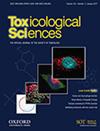优雅类神经退行性疾病背景下铜介导的神经毒性和遗传脆弱性
IF 3.4
3区 医学
Q2 TOXICOLOGY
引用次数: 0
摘要
阿尔茨海默病(AD)和帕金森病(PD)等神经退行性疾病的相关机制尚未完全定性,其病因中的遗传和环境因素也未得到充分认识。虽然 PARKIN 和 LRRK2 等基因的突变与帕金森病有关,但该病的特发性成分表明环境风险因素也有影响,其中包括铜(Cu)等金属。据报道,过度接触铜会导致氧化应激和神经毒性,但很少有人研究铜在神经退行性疾病中的作用。我们利用秀丽隐杆线虫(C. elegans)作为神经毒性的模式生物,评估了铜过量供应对AD和PD模型的影响。我们的研究结果表明,虽然铜处理不会诱导野生型蠕虫或AD模型的神经变性,但会显著加剧与PD相关的突变体PARKIN和LRRK2的神经变性。这些结果表明,帕金森病的遗传易感性增强了对铜毒性的敏感性,凸显了神经退行性疾病的多因素性质。此外,我们的研究还揭示了铜在帕金森病模型中诱导神经毒性的机制,包括多巴胺水平紊乱、多巴胺依赖行为改变和多巴胺能神经元退化。总之,我们的新发现有助于更好地理解遗传易感性、环境因素和神经退行性疾病发病机制之间复杂的相互作用,并强调了铜平衡的严格调节在帕金森病病因学中的重要性。本文章由计算机程序翻译,如有差异,请以英文原文为准。
Copper-mediated neurotoxicity and genetic vulnerability in the background of neurodegenerative diseases in C. elegans
The mechanisms associated with neurodegenerative diseases, such as Alzheimer’s disease (AD) and Parkinson’s disease (PD) have yet to be fully characterized, and genetic as well as environmental factors in their disease etiology are under appreciated. While mutations in genes such as PARKIN and LRRK2 have been linked to PD, the idiopathic component of the disease suggests a contribution of environmental risk factors, including metals, such as copper (Cu). Cu overexposure has been reported to cause oxidative stress and neurotoxicity, but its role in neurodegenerative diseases is rarely studied. Using Caenorhabditis elegans (C. elegans) as a model organism for neurotoxicity, we assessed the effects of Cu oversupply in AD and PD models. Our findings reveal that while copper treatment did not induce neurodegeneration in wildtype worms or the AD model, it significantly exacerbated neurodegeneration in the PD-associated mutants PARKIN and LRRK2. These results suggest that genetic predisposition for PD enhances the sensitivity to copper toxicity, highlighting the multifactorial nature of neurodegenerative diseases. Furthermore, our study provides insight into the mechanisms underlying Cu-induced neurotoxicity in PD models, including disruptions in dopamine levels, altered dopamine-dependent behavior and degraded dopaminergic neurons. Overall, our novel findings contribute to a better understanding of the complex interactions between genetic susceptibility, environmental factors, and neurodegenerative disease pathogenesis, emphasizing the importance of a tightly regulated Cu homeostasis in the etiology of PD.
求助全文
通过发布文献求助,成功后即可免费获取论文全文。
去求助
来源期刊

Toxicological Sciences
医学-毒理学
CiteScore
7.70
自引率
7.90%
发文量
118
审稿时长
1.5 months
期刊介绍:
The mission of Toxicological Sciences, the official journal of the Society of Toxicology, is to publish a broad spectrum of impactful research in the field of toxicology.
The primary focus of Toxicological Sciences is on original research articles. The journal also provides expert insight via contemporary and systematic reviews, as well as forum articles and editorial content that addresses important topics in the field.
The scope of Toxicological Sciences is focused on a broad spectrum of impactful toxicological research that will advance the multidisciplinary field of toxicology ranging from basic research to model development and application, and decision making. Submissions will include diverse technologies and approaches including, but not limited to: bioinformatics and computational biology, biochemistry, exposure science, histopathology, mass spectrometry, molecular biology, population-based sciences, tissue and cell-based systems, and whole-animal studies. Integrative approaches that combine realistic exposure scenarios with impactful analyses that move the field forward are encouraged.
 求助内容:
求助内容: 应助结果提醒方式:
应助结果提醒方式:


